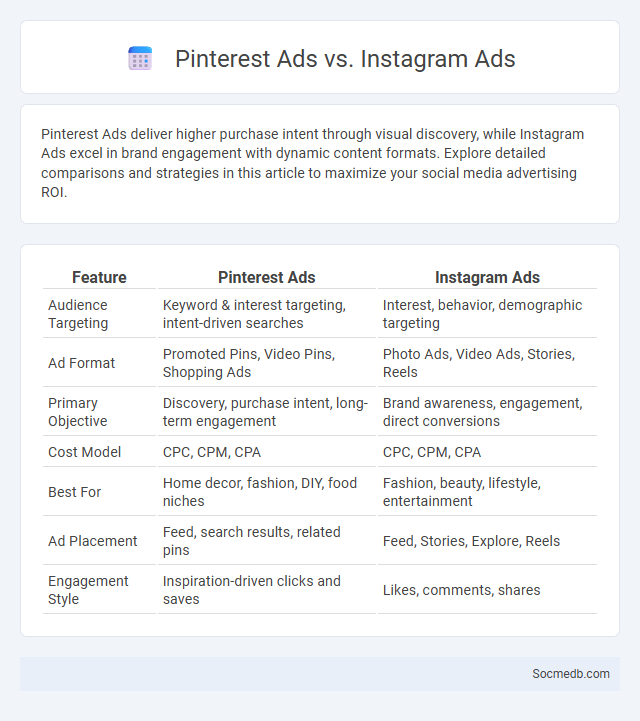
Photo illustration: Pinterest Ads vs Instagram Ads
Pinterest Ads deliver higher purchase intent through visual discovery, while Instagram Ads excel in brand engagement with dynamic content formats. Explore detailed comparisons and strategies in this article to maximize your social media advertising ROI.
Table of Comparison
| Feature | Pinterest Ads | Instagram Ads |
|---|---|---|
| Audience Targeting | Keyword & interest targeting, intent-driven searches | Interest, behavior, demographic targeting |
| Ad Format | Promoted Pins, Video Pins, Shopping Ads | Photo Ads, Video Ads, Stories, Reels |
| Primary Objective | Discovery, purchase intent, long-term engagement | Brand awareness, engagement, direct conversions |
| Cost Model | CPC, CPM, CPA | CPC, CPM, CPA |
| Best For | Home decor, fashion, DIY, food niches | Fashion, beauty, lifestyle, entertainment |
| Ad Placement | Feed, search results, related pins | Feed, Stories, Explore, Reels |
| Engagement Style | Inspiration-driven clicks and saves | Likes, comments, shares |
Introduction to Social Media Advertising
Social media advertising leverages platforms like Facebook, Instagram, and LinkedIn to target specific audiences with tailored content, increasing brand visibility and engagement. By analyzing user behavior and demographics, businesses can optimize ad campaigns for higher conversion rates and improved ROI. You can effectively reach potential customers and grow your online presence through strategic social media ads.
Overview of Pinterest Ads
Pinterest Ads offer businesses a unique platform to reach a highly engaged audience interested in inspiration and discovery. The ad formats include Promoted Pins, Video Pins, and Shopping Ads, enabling brands to showcase products effectively while driving traffic and conversions. Advanced targeting options such as interest, keyword, and demographic targeting help maximize the relevance and impact of campaigns on Pinterest.
Overview of Instagram Ads
Instagram Ads offer a powerful platform for businesses to reach over 1 billion active users through visually engaging content. These ads support multiple formats, including photo, video, carousel, and Stories, allowing brands to tailor messages for targeted audience segments. Advanced targeting options leverage Facebook's extensive data, enabling precise demographic, interest, and behavior-based advertising to maximize ROI.
What is Paid Promotion?
Paid promotion on social media involves using paid advertisements to increase the visibility of your content, products, or services across platforms like Facebook, Instagram, and LinkedIn. These promotions target specific audiences based on demographics, interests, and behaviors to maximize engagement and conversions. Your investment in paid campaigns enables precise reach and measurable results compared to organic posts.
Audience Targeting Capabilities
Social media platforms offer advanced audience targeting capabilities that allow you to reach specific demographics based on behavior, interests, geography, and purchasing habits. Leveraging tools like Facebook Ads Manager and LinkedIn Campaign Manager enables precise segmentation to maximize engagement and conversion rates. These targeted strategies enhance your marketing ROI by delivering personalized content to the most relevant users.
Ad Formats and Creative Options
Social media platforms offer diverse ad formats such as image ads, video ads, carousel ads, and Stories ads, each tailored to optimize user engagement and conversion rates. Creative options include interactive elements like polls, augmented reality filters, and shoppable tags to enhance audience interaction and drive sales. Leveraging platform-specific analytics allows advertisers to refine creatives and target demographics effectively, maximizing ROI on campaigns.
Cost and Budget Considerations
Social media marketing costs vary widely based on platform, campaign goals, and targeting precision, with average CPM (cost per thousand impressions) ranging from $5 to $15 on major platforms like Facebook and Instagram. Budget considerations must include content creation, paid advertisements, and analytics tools, often requiring a monthly allocation starting at $1,000 for small businesses. Efficient budget management leverages audience segmentation and A/B testing to optimize ad spend and maximize ROI across channels.
Performance Metrics and Analytics
Performance metrics and analytics in social media provide critical insights into audience engagement, content reach, and conversion rates, enabling businesses to optimize marketing strategies effectively. Key indicators such as click-through rates (CTR), engagement rate, follower growth, and impressions offer quantifiable data to measure campaign success. Advanced analytics platforms integrate AI-driven sentiment analysis and demographic segmentation to refine targeting and enhance ROI on social media investments.
Use Cases: Which Platform is Best for Your Business?
Facebook excels in B2C marketing with robust targeting tools and vast user demographics, ideal for brand awareness and customer engagement. LinkedIn is the preferred platform for B2B businesses, offering precise professional targeting and lead generation opportunities. Instagram and TikTok drive strong visual storytelling and influencer marketing, making them perfect for brands aiming to connect with younger, trend-savvy audiences.
Conclusion: Choosing the Right Advertising Platform
Selecting the right advertising platform hinges on understanding your target audience's demographics and engagement behaviors. Social media channels like Facebook, Instagram, and LinkedIn offer tailored tools that optimize ad reach and conversion rates based on user data. By aligning your marketing goals with the platform's unique strengths, you maximize your campaign's effectiveness and return on investment.
 socmedb.com
socmedb.com